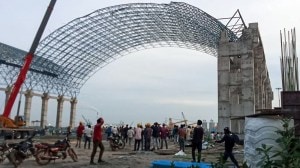Better accuracy, but many limitations still plague Delhi’s air quality forecasting, shows study
A key limitation is old source data, notes the study by think tank CEEW; says emission inventories should be updated ideally every 2-3 years. Also, despite the availability of advance forecasts, policy actions remain largely reactive, and not preemptive.
 The study has flagged the persistent underprediction of particulate matter pollution load. (Source: Express Archives)
The study has flagged the persistent underprediction of particulate matter pollution load. (Source: Express Archives)Delhi’s Air Quality Early Warning System (AQEWS) has been able to forecast high-pollution days with more than 80 per cent accuracy, but its reliance on outdated emission inventories and the tendency to underpredict pollutant levels limit its effectiveness, a study by the public policy think tank Council on Energy, Environment, and Water (CEEW) has found.
The system correctly forecast 83 out of the 92 “very poor and above” days in the winter of 2023-24, and 54 out of 58 such days in 2024-25, says the study, titled ‘How Well Can Delhi Predict Air Quality?’. ‘Very poor and above’ days are those on which the air quality index (AQI) is more than 300.
The AQEWS is run by the Indian Institute of Tropical Meteorology (IITM), Pune, and the India Meteorological Department (IMD). It was launched by the Union Ministry of Earth Sciences in 2018 to forecast Delhi’s air quality three days in advance. In 2021, a Decision Support System (DSS) that tracks sectoral and regional contributions to PM2.5 pollution, was integrated into the system.
According to the study, the ability of AQEWS to detect the most severe episodes of air pollution remains poor, even though improvements have been seen over the past year. “While the AQEWS could only predict 1 out of 15 air pollution episodes with an AQI > 400 in 2023-24, it forecast 5 out of 14 such episodes in 2024-25,” it notes.
The study has flagged the persistent underprediction of particulate matter pollution load.
In 2023-24, the mean absolute percentage error (MAPE) for PM2.5 forecasts from the WRF-Chem model was 35 per cent, and for PM10, it was 37 per cent. In 2024-25, while the error for PM2.5 remained 35 per cent, that for PM10 worsened to 38 per cent.
The performance fell sharply during late winter 2024-25, says the study: “The MAPE for PM2.5 and PM10 during the post-peak winter phase was 36 per cent and 39 per cent respectively. It deteriorated to 73 per cent and 57 per cent for PM2.5 and PM10 respectively in 2024-25.”
In a statement, CEEW said: “Delhi’s DSS currently operates only in winter, limiting its usefulness for tracking pollution sources throughout the year. To be fully effective, it should run year-round and incorporate modelling scenarios such as the impact of restricting certain vehicle types or the potential air quality improvements from enhanced public transportation.”
Dr Mohammad Rafiuddin, Programme Lead, CEEW, who is one of the authors of the study, emphasised “sector-proportionate action”, and called for the updation of emission inventories (EI) (which are lists of pollutants released by natural and human-caused sources in a geographical region over a specified timeframe).
A key limitation is outdated source data, the study notes. “The AQEWS and DSS rely on multiple emission inventories. For NCR districts, the systems utilise the EI developed by TERI for 2016; for Delhi, they employ the 2018 EI developed under the SAFAR project,” the report says.
In December 2024, the Commission for Air Quality Management (CAQM), the statutory air pollution watchdog for the NCR, announced that it would no longer use the DSS for decision-making because of the outdated inventories.
The study also observed that while forecasts are available in advance, the policy actions are still largely reactive, and not preemptive.
“Although the GRAP schedule directs implementation of the restrictions under the GRAP based on forecasts, we observe that the CAQM imposed GRAP Stages III and IV based on the observed AQI,” it says. The Graded Response Action Plan (GRAP) is a framework to combat air pollution in the NCR through the implementation of progressively stricter measures as air quality worsens.
In 2024-25, Stage III restrictions were imposed six times and Stage IV twice, but always after AQI thresholds had been breached.
India’s emission inventories should be updated regularly, ideally every two to three years, the study has recommended. DSS, it has said, should operate round the year, and forecast data should be available publicly.
“A revamped system running year-round with an updated EI, along with bias-corrected forecasts, would strengthen the air quality mitigation measures in the NCR region,” the study says.







